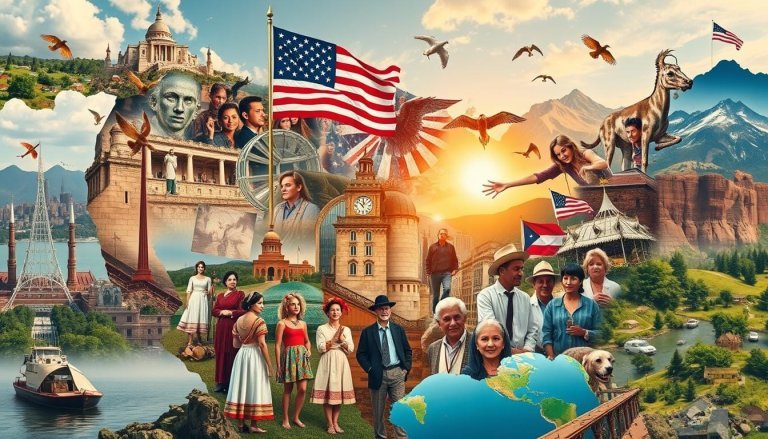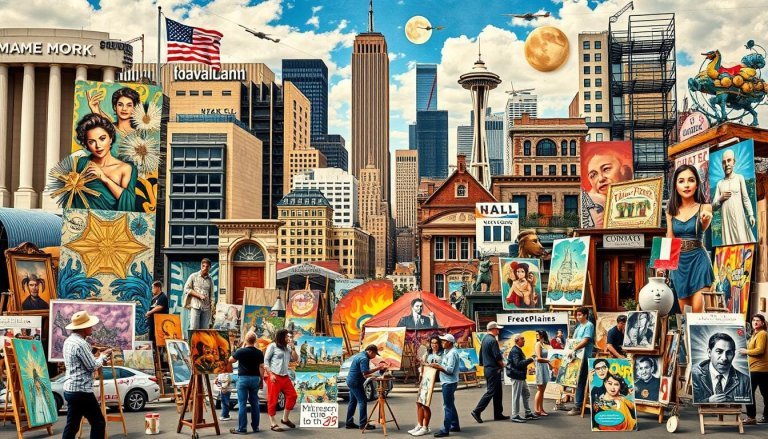The USA is full of diverse regions. Each has its own culture and people. From big cities by the sea to inland cities, America’s diversity is everywhere.
California is the most diverse in culture and economy. It has the biggest Hispanic population. Texas is close behind, with many Hispanics and African Americans. Hawaii is the most diverse in race and ethnicity.
New York City is a global center of cultures. It has many ethnic neighborhoods. Houston, Texas, is known for its food and culture, showing off Texas’s Hispanic roots.
Across the USA, each region is unique. The Northeast is diverse in languages, with Jersey City leading. The Southwest, like New Mexico, honors Native American and Hispanic traditions.
Let’s dive into these diverse areas. We’ll see what makes each place special in America’s multicultural world.
Understanding USA diverse regions: Cultural and Demographic Patterns
The United States is a mix of many cultures. This mix comes from different people and local ways of life. You can see this in the food and the communities across the country.
Defining diversity metrics and measurements
Diversity in the USA is tracked in many ways. These include race, language, and how many people were born outside the country. The 2020 census shows a wide range of ethnic groups:
- White Americans: 61.6%
- Hispanic and Latino: 18.9%
- Black or African American: 12.4%
- Asian: 6.0%
- Native American or Alaska Native: 2.9%
Distribution patterns across metropolitan areas
Diversity changes a lot from place to place. The Midwest has the most White Americans, at 74.6%. But the West is the most diverse, with only 51.9% White Americans. The South has 55% of African Americans, and the West has 42% of Hispanic and Latino Americans.
Impact of immigration on regional diversity
Immigration greatly affects regional diversity. Many cities have more people born outside the country. For example, Irving, Texas saw its foreign-born residents go from 33% to 38% between 2010 and 2019. This brings new ideas and makes local traditions and food richer.
| Region | White Americans (%) | Non-Hispanic Whites (%) | Notable Diversity Characteristics |
|---|---|---|---|
| Midwest | 74.6 | 73.0 | Highest proportion of White Americans |
| Northeast | 64.0 | 62.0 | Second-highest proportion of White Americans |
| South | – | 57.7 | Home to 55% of African American population |
| West | 51.9 | 47.1 | Most diverse region, hosts 42% of Hispanic and Latino Americans |
Top Diverse Metropolitan Areas and Their Characteristics
The United States has many diverse cities. Each city has its own mix of cultures and landscapes. These cities show how the country’s population and immigration have changed.
New York City’s Ethnic Mosaic
New York City is a perfect example of America’s diversity. It has about 8.5 million people. The city is made up of many ethnic groups.
There are 42.7% White, 29.1% Hispanic or Latino, 24.3% Black or African American, and 13.9% Asian people. The city has many cultural areas like Little Italy and Chinatown. These areas make New York special.
Houston’s Growing Diversity Ecosystem
Houston is known for its diversity. It has about 2.29 million people. The city is 46.8% White, 44.5% Hispanic or Latino, 22.6% Black or African American, and 6.8% Asian.
Houston is not just diverse in ethnicity. It also has different cultures and ways of life. This shows how the city has changed over time.
California’s Diverse Coastal Regions
California’s coast is very diverse. San Francisco has 815,200 people. The city is 51% White, 37% Asian, 15.9% Hispanic or Latino, and 6% Black or African American.
Los Angeles is even more diverse. It has 3.85 million people. The city is 49% Hispanic or Latino, 46.9% White, 28.9% Asian, and 11.7% Black or African American.
Both cities show how California’s population is changing. They reflect the state’s varied landscapes and cultures.



